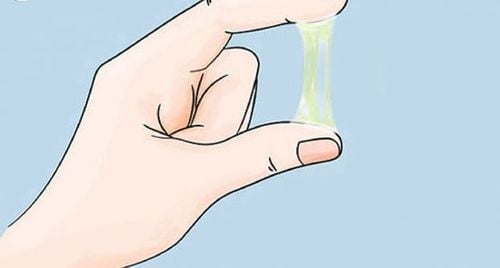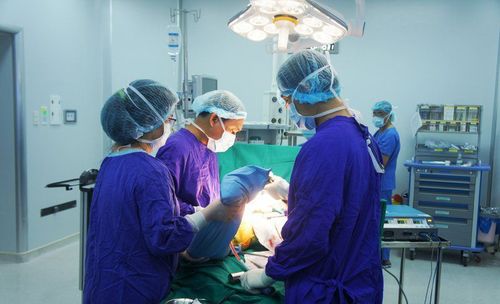This is an automatically translated article.
Vaginal fistula is when there is an abnormal opening that connects a woman's vagina to another organ, such as the urethra, bladder, colon, or rectum. Patients can go to the doctor when they see that the condition of stool or urine passing through the vagina is prolonged, which greatly affects the quality of life.
Vaginal fistulas can form as a result of trauma, surgery, infection or radiation therapy, or a birth defect. Whatever the cause of the fistula, surgical closure of the vaginal fistula to restore normal urinary function is always indicated.
1. What is a vaginal fistula?
Vaginal fistulas occur when there is an abnormal opening between the vaginal tract and other organs in the pelvis, urethra, bladder, colon or rectum. The result can be stool and urine leaking into the vagina due to this abnormal connection. In particular, due to the anatomical characteristics of the urogenital region in women, fistulas between the vagina and the urethra are the most common.
The cause of fistulas affecting the urinary tract is usually tissue damage of the urinary tract, pelvis or vagina and can facilitate fistula formation. Leakage of urine into the vagina can develop from an injury or accident, surgery, radiation treatment, or from an infection, although this is less common. Fistula progression can unfold after tissue rupture over time, from days to years.

Lỗ rò âm đạo trực tràng
In fact, a vaginal fistula occurs as a complication of the following situations:
Total hysterectomy C-section delivery Other surgery on the back wall of the vagina, perineum, anus, or rectum Tumors malignancy in the pelvic area, such as colon or cervical cancer Radiation therapy for pelvic cancer, which can cause tissue to become fragile and fragile Chronic inflammatory bowel disease or inflammation diverticulum Infection of the perineal incision after childbirth.
2. Symptoms of vaginal fistula like?
The presence of a fistula is usually painless, except when there are signs of infection or inflammation. Most women are self-aware that they have an abnormal fistula. At this point, what causes them to go to the doctor for symptoms include:
Continuous vaginal leakage of urine in nature Heavy vaginal discharge Feces leaking into the vagina if present fistulas of colon and rectum Frequent urinary tract infections Gas escaping from the urethra during urination Increased sensitivity, irritation in the vulva region Frequent dull abdominal pain.

Phụ nữ xuất hiện nhiều khí hư
3. How to diagnose vaginal fistula?
The patient's symptoms along with a history of previous urogenital interventions will help guide the diagnosis of vaginal fistula easily.
However, to confirm the diagnosis as well as investigate the features of the fistula, the anatomical structure of the involved parts to support the intervention process, the doctor will need to perform some more tests:
A urine sample will be sent to a lab for analysis, to check for infections or other problems in the urinary tract. Complete blood count to look for indicators of infection Lower urinary tract imaging using contrast dye injected into the urinary tract and X-rays to examine bladder and urethra and detect fistulas Vagina or other organ?
Cystoscopy to examine the urethra and bladder, looking for fistulas or other lesions Hysteroscopy to examine the vagina, look for fistulas or other lesions Colonoscopy to examine the anus and rectum, check for fistulas or other damage Pelvic computed tomography or magnetic resonance imaging (MRI) to create detailed images of the internal organs and tissues in the pelvic floor area, helping the doctor locate the fistula , determine the size and orientation of the intervention.

Nội soi đại trực tràng giúp chẩn đoán lỗ rò âm đạo
4. How to treat vaginal fistula?
Regardless of the cause of vaginal fistula formation, once symptoms are present, in most cases, surgery to close the vaginal fistula is always indicated.
Before performing the intervention, the surgeon needs to clearly determine the type and location of the fistula. In fact, some surgeries can be done through the vagina while some are done through the abdomen. On the other hand, some cases can be repaired with laparoscopic surgery, which is done through very small incisions, or robotic surgery that involves very precise micro-motions.
The goal of surgery is to repair the fistula so that healthy tissue can grow and close the fistula, restoring normal function of the affected organs. The surgeon will work to remove the damaged tissue and also any other abnormal tissue such as a tumor that may be affecting the fistula.
Accordingly, before surgery, the patient and family are always very well explained about the procedure to be carried out, about the treatment goals as well as the possible risks around surgery and after surgery. For the group of patients with accompanying medical diseases, these subjects need to be stabilized and ensure their general condition first, thereby limiting the possibility of related complications due to geographical location, disease. disability. Before the day of surgery, the patient will be instructed to fast, do enemas to empty the entire colon, clean the surgical area and wash the whole body with an antiseptic solution, change the clothes as prescribed.

Định kỳ kiểm tra sức khỏe phụ khoa là việc làm cần thiết của phụ nữ
As soon as we move into the operating room, because this is an infectious surgery, all patients need to be given prophylactic antibiotics before surgery. The surgeon will begin by disinfecting the entire surgical site, including the abdomen below the navel, vagina, and perineum. A urethral catheter will be placed into the urethra to direct urine from the bladder out, stored in a bag hanging by the operating table. Then, the vaginal canal and the urethral-vaginal fistula are exposed using a specialized gynecological instrument called a speculum. Thanks to this, the doctor can give local anesthesia and perform fistula dissection, filter out damaged tissue around the circumference of the fistula in the vaginal wall. Next, the vaginal wall at the fistula would be separated from the urethral wall, the fistula would be excised, and the lateral opening of the fistula closed on the side of the urethral wall with a slow fixation. Similarly, the external opening of the fistula on the side of the vaginal wall is also sutured closed. Finally, the entire area will be examined to ensure there are no residual fistulas and thoroughly disinfected before surgery is terminated.
After surgery to close the vaginal fistula, the patient will need to keep the catheter in the bladder for several weeks. The catheter can only be removed when the area of the fistula has completely healed. In contrast, extubation too early will cause new tissue to grow to close the damaged fistula, leading to the possibility of recurrent fistula formation. At the same time, the patient should also be advised to abstain from penetrative sexual activities during this period as well as vaginal interventions such as douching...
Closing vaginal fistulas by surgical intervention is always indicated. Therefore, women need to know full information about this disease, go to the doctor early to receive appropriate treatment. From there, the patient can regain confidence in life as well as the happiness of the couple.
References: mayoclinic.org, denverurology.com













